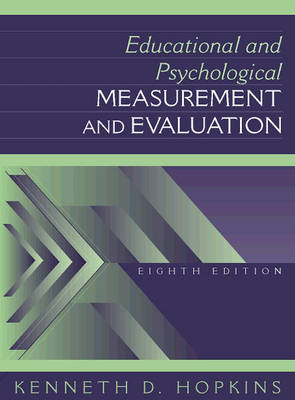
Educational and Psychological Measurement and Evaluation
Pearson (Verlag)
978-0-205-16087-7 (ISBN)
- Titel ist leider vergriffen;
keine Neuauflage - Artikel merken
Going into its eighth edition, this book is a classic in the field of educational measurement. Educational and Psychological Measurement and Evaluation, Eighth Edition was written from the point of view of the classroom teacher to answer the question, “What does a teacher need to know about the development and evaluation of educational measures and assessments?” This book fosters an understanding of how assessment and instruction are interrelated. It also cultivates learning the techniques and skills needed to develop tests and other evaluation procedures (e.g. portfolios), as well as teaches students to understand how to evaluate the validity and reliability of tests.
Unlike many textbooks in educational measurement, this book also gives teachers, principals, or counselors what they need to know to properly interpret the results from standardized achievement and scholastic aptitude tests.
Each chapter opens with “Introduction” and closes with “Chapter Tests.”
Preface.
I.BASIC CONCEPTS.
1.Measurement: Its Nature and Function.
Assessment and Measurement.
How Much Precision Is Needed?
Variables That Are Not Directly Observable?
Observation and Quantification.
The Paradox of Testing.
The Respectful Use of Tests.
Measurement and Evaluation in the Educational Process.
Subjectivity and Objectivity.
Educational Decisions Founded on Evaluation.
Essential Knowledge and Skills.
The Goals and Functions of Testing.
Instructional Functions.
Administrative Functions.
Research and Evaluation.
Guidance Functions.
2.Communicating Information: Interpretation of Quantitative Data.
Frequency Distributions, Central Tendency, and Skewness (programmed).
Classification and Tabulation.
The Ungrouped Frequency Distribution.
Central Tendency and Variability.
The Median.
The Mean.
The Mode.
Comparisons of the Mean, Median, and Mode.
Measures of Variability.
The Meaning of Variability.
The Range.
The Variance and Standard Deviation.
Which Measure Is Best?
3.The Meaning and Application of Norms.
Norms Are Not Standards.
The Normal Distribution.
Many Measures Report Scores That Are Based on the Normal Curve.
Standard Scores Are Useful in Describing Performance.
z-Scores.
The T-Scale.
Stanines.
Normal Curve Equivalent (NCE) Scores.
Norms Provide a Means of Comparison with a Reference Group.
A Representative Sample Is Needed for Accurate Norms.
Norms Should Be Relevant.
Norms Should Be Current.
4.Test Validity.
Content Validity.
Criterion-Related Validity.
Correlation and Prediction (programmed).
The Concept of Correlation.
Correlation and Scatterplots.
Interpreting Correlation Coefficients.
Correlation vs. Causation.
Influence of N.
Validity Coefficients.
Some Examples of Criterion-Related Validity.
Another Example of Predictive Validity.
How Large Does a Validity Coefficient Need to Be?
Expectancy Tables.
Concurrent Validity.
Validity Consequences of the Reliability of the Criterion.
The Effect of Restricted Variability on Criterion-Related Validity.
Construct Validity.
5.Test Reliability.
Errors of Measurement and Reliability.
Reliability and True Scores.
True Scores.
The Standard Error of Measurement.
The Standard Deviation and the Standard Error of Measurement.
Some Test Theory.
Index of Reliability vs. Reliability Coefficient.
Regression Toward the Mean.
Estimating True Scores from Observed Scores.
Test Length, Reliability, and The Spearman-Brown Prophecy Formula.
Test Length.
Estimating Reliability: The Test-Retest Method.
Parallel-Form Reliability.
The Split-Half Method.
Reliability via Internal Consistency.
Kuder-Richardson Formula 20.
Coefficient Alpha.
Kuder-Richardson Formula 21.
Speeded Tests.
What Is a High Reliability Coefficient?
6.Extraneous Factors that Influence Performance of Cognitive Tests.
Test Sophistication, Practice, and Coaching.
Practice.
Coaching.
Anxiety and Motivation.
Response Styles.
The Speed vs. Accuracy Set.
The Acquiescence Set.
The Positional-Preference Set.
The Option Length Set.
The Set to Gamble.
Corrective Measures for the Gambling Set.
Elimination Scoring and Answer-until-correct Procedures.
Confidence Weighting.
Some Conclusions Regarding Response Sets.
Mode of Administration.
Examiner Effects.
Advanced Announcement of Testing.
Answer Sheet Format.
Scoring.
Disturbance.
Answer Changing.
Cheating.
II.THE DEVELOPMENT OF EDUCATIONAL MEASURES.
7.General Principles of Test Construction: Achievement Measures.
Planning the Test.
Instructional Objectives.
Specificity of Objectives.
A Taxonomy of Objectives.
Knowledge Level Items.
Comprehension and Application.
Analysis, Synthesis, and Evaluation.
Research on the Taxonomy Hierarchy.
Other Item Classifications.
Content and Process Objectives.
Test Items Are Samples.
Diagnostic Testing.
The Nature of the Test.
Criterion-Referenced Testing.
Norm-Referenced vs. Criterion-Referenced Testing.
Minimum Competency Testing.
Test Development Plan.
8.Constructing and Using Essay Tests.
Oral Examination.
Written Tests.
Scientific Proficiency Measures: An Early Example.
Essay Tests as Measures of Achievement.
Limitations of the Essay Test.
Reader Unreliability.
The Halo Effect.
Item-to-Item Carryover Effects.
Test-to-Test Carryover Effects.
Order Effects.
Language Mechanic Effects.
Computer Scoring.
Essay Test Reliability.
Indirect Measures of Writing Ability.
The Essay as a Measure of Writing Ability.
The Decline in Writing Ability.
Essay Tests in College Admissions.
First-Draft Versus Final-Draft Skills.
Contest Validity of Essay Tests in Other Curricular Areas.
Advantages of Essay Tests as Achievement Measures.
Improving the Development and Use of Essay Tests.
Preparing Students to Take Essay Tests.
Constructing Good Essay Tests.
Improving the Grading of Essay Tests.
The Use of Anchor Points in Scoring.
Anonymity.
Style.
Proper Use of Essay Exercises.
9.Constructing Objective Tests.
Fixed-Response Items.
Multiple-Choice Items.
Rationale for the Multiple-Choice Item.
Ambiguous vs. Trick Questions.
Intrinsic vs. Extrinsic Ambiguity.
Inverse Multiple-Choice Items.
Illustrations of Multiple-Choice Items.
General Guidelines for Test Development.
Special Guidelines for Constructing Multiple-Choice Items.
True-False and Two-Option Items.
Suggestions for Constructing True-False Items.
Matching Exercises.
Illustrations of Matching Exercises.
Suggestions for Constructing Matching Exercises.
Short-Answer Items.
Illustrations of Short-Answer Items.
Completion Items.
Illustrations of Completion Items.
Suggestions for Constructing Short-Answer Items.
Cloze Tests.
Concluding Remarks.
10.Item Analysis for Classroom Tests.
Information Yielded by an Item Analysis.
Procedures for an Item Analysis.
The Steps of an Item Analysis.
Item Difficulty and Item Discrimination.
Item Discrimination and Test Reliability.
An Illustrative Analysis.
Other Examples.
Item Analysis in State and Large Scale Assessments.
11.The Assessment of Affective Variables.
The Affective Taxonomy of Educational Objectives.
Cognitive versus Affective Appraisal.
Thurstone Attitude Scales.
Likert Scales.
Rating Scales.
Semantic Differential Scales.
Self-Report Inventories.
Self-Concept.
Q-sort Techniques.
Questionnaires.
Adjective Checklists.
Interviews.
Problems of Affective Measurement.
The Social-Desirability Response Style.
Self Deception.
Semantic Problems.
Criterion Inadequacy.
Naturalistic Observation, Unobtrusive and Non-Test Measures.
Invasion of Privacy.
12.Grading and Reporting.
Objections to Grades.
Testing and Grading.
Marks and Criterion-Referenced Measures.
Grading on the Curve.
Narrative Reports.
Parent Conferences.
Other Alternatives.
Portfolios.
The Meaning of Marks.
The Criterion of Quality.
Achievement in Relation to an Absolute Standard.
Achievement in Relation to Aptitude.
Individual Student Growth.
Achievement in Relation to Peer Achievement.
A Better Proposal?
Assigning Marks and Weighting Components.
Homework and Marking.
Numbers of Categories.
Suggestions for Improving Marking and Reporting.
III.STANDARDIZED MEASURES.
13.Measuring Scholastic Aptitude.
The Search for a Valid Measure of Intelligence.
Galton and The Study of Human Differences.
Binet's Breakthrough.
The Stanford-Binet Scale.
Performance and Group Tests.
Nonverbal Tests.
Changing Views of Intelligence Testing.
Tests Designed for Admissions Decisions.
The Nature of Intelligence.
Wechsler Intelligence Tests.
Other Views of Intelligence.
The Kaufman Assessment Battery for Children (K-ABC).
Infant Intelligence Scales.
Intelligence Growth Curves.
The Reliability of Intelligence Tests.
The Ratio IQ.
The Deviation IQ.
IQ Constancy: Common Variance Versus Score Stability.
The Relationship Between IQ and Scholastic Achievement.
Construct Validity.
Intelligence and Occupational Level.
Multiple-Aptitudes Batteries.
Cultural Influences on Test Scores.
Assessing Creativity.
Using Tests to Identify and Help Gifted Children.
Representative Cognitive Ability Tests.
14.Standardized Achievement Tests.
Advantages of Standardized Tests.
The Aptitude-Achievement Continuum.
Content Validity.
Norms on Standardized Achievement Tests.
Co-normal Scholastic Aptitude and Achievement Tests.
Item Norms and Class, School, and District Evaluation.
School Versus Individual Norms.
Interpreting Grade Equivalents.
Longitudinal Study of Individual Progress.
Diagnostic Use of Test Results.
Content Validity of Standardized Achievement Tests: The Sampling of the Content Universe.
Teachers' Ratings as Validation Criteria.
“Out-of-Level” Testing.
Special Problems of Standardized Testing in High School.
The National Assessment of Educational Progress (NAEP).
The School Testing Program.
Selecting the Appropriate Test or Tests.
Locating Available Standardized Tests.
Test Administration and Scoring.
State Assessments.
Interpretation of District Results in Relation to Scholastic Aptitude.
Achievement Stability.
Bias and Achievement Tests.
Measuring the Difficulty of Reading Material.
15.Standard Interest, Personality, and Social Measures.
Vocational Interest Inventories.
The Strong Interest Inventory.
The Kuder Interest Inventories.
Ipsative Versus Normative Scales.
Reliability and Validity of Interest Inventories.
Fakability.
Measured Versus Expressed Interests.
Interests, Abilities, and Grades.
The Measurement of Personality Variables.
Traits Assessed by Direct and Naturalistic Observation.
Trait Measurement Through Self-Report.
Special Problems in Personality Measurement.
Trait Instability.
The Social Desirability Response Style.
The MMPI.
California Psychological Inventory.
The Minnesota Teacher Attitude Inventory.
Evaluation of Self-Report Measures.
The Assessment of Motives: Projective Techniques.
The Rorschach.
The Thematic Apperception Test.
Other Projective Techniques.
Copying Techniques.
Evaluation of Projective Techniques.
Measuring School and Institutional Climate.
Matrix Sampling.
Sociometric Techniques.
Sociometry and Peer Ratings.
The “Guess Who” Technique.
Reliability and Validity of Sociometric Data.
Appraising Socioeconomic Status.
The Warner-Meeker-Eells Scale.
The Hollingshead Index.
Appendices.
A. Resources for the Development and Selection of Measuring Instruments.
B. Major Publishers of Standardized Tests.
Bibliography.
Name Index.
Subject Index.
| Erscheint lt. Verlag | 23.12.1997 |
|---|---|
| Sprache | englisch |
| Maße | 242 x 185 mm |
| Gewicht | 780 g |
| Themenwelt | Geisteswissenschaften ► Psychologie ► Test in der Psychologie |
| Sozialwissenschaften ► Pädagogik | |
| ISBN-10 | 0-205-16087-5 / 0205160875 |
| ISBN-13 | 978-0-205-16087-7 / 9780205160877 |
| Zustand | Neuware |
| Haben Sie eine Frage zum Produkt? |
aus dem Bereich


